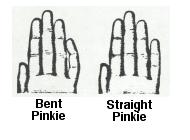
OBJECTIVE:
In this lab you will discover some basic concepts of human genetics. You will observe both autosomal and sex linked trait transmissions, in this lab
INTRODUCTION:
Genetics is concerned with the mechanisms whereby traits are passed from parent to offspring. These genes code for a genotype which code for a specific trait. An allele is the alternate form of trait found on the same gene loci. A phenotype is the trait that you can observe. For example, a person’s phenotype would be hair color or any observable trait. The genotype are the genes that code for the phenotype. Some genes are dominant, meaning that the gene is expressed in all offspring carrying that gene. Other genes are recessive, where you carry the gene but it is not expressed. Homozygous genes are two of the same gene (GG or gg). Heterozygous genes are two different genes (Gg).
This lab is divided into two parts. The first
deals with autosomal traits. The second part reviews sex linked traits.
PART ONE
OBSERVATIONS:
The following are autosomal traits which are caused by a single gene.
PTC Tasting
Phenylthiocarbamide (PTC) is a non toxic chemical
that some individuals can taste. The ability to taste this bitter
chemical is inherited through a dominant gene. If you can not taste
or are a non taster, you carry the recessive genes. Lets assign the
letter “T” for the tasting trait and “t” for the recessive non tasting
gene. If you can taste the PTC you carry the dominant gene T.
If you can not taste you have inherited the homozygous recessive trait
“tt”.
Take a small piece of control paper. This paper is not treated with any of the PTC chemical. Chew it and mark any observations below. Then place the chewed paper in the bin marked biologicals/body fluids.
____________________________________________________________________________________________________________________________
____________________________________________________________________________________________________________________________
Take a small piece of control paper. This paper is treated with the PTC chemical. Chew it and mark any observations below. Then place the chewed paper in the bin marked biologicals/body fluids.
____________________________________________________________________________________________________________________________
____________________________________________________________________________________________________________________________
What is your genotype for this trait? ___________________________________
Bent Little Finger
Lay your hands flat on the table and relax them.
Does the last joint of your little finger bends toward the forth finger
(see the diagram below)?. If you have the bent pinkie finger you
have the dominant allele “B”. If the fingers are straight and extend
parallel to each other out to the very tip, you carry the recessive allele
“b”.

What is your genotype for this trait? ___________________________________
Pigmented Iris
If you are homozygous for the recessive allele
“p”, you do not produce pigment in the front layer of your iris.
If you have no pigment you have either blue or gray eyes. The “P”
allele produces the pigment which gives you eye color. Eye colors
are green, hazel, brown or black.
What is your genotype for this trait? ___________________________________
What is your phenotype? _________________________________________
Attached Earlobes
Some individuals have earlobes which are attached
to the side of their head and others have free or unattached earlobes (see
diagram below). The unattached or free earlobe trait is dominant
over the attached lobe trait.

What is your phenotype ? _________________________________________
Tongue Rolling
The ability to roll your tongue (see diagram below),
is the result of a dominant gene. If you cannot roll your tongue
you carry the recessive trait.
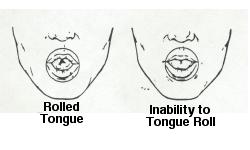
What is the non tongue rolling genotype ?______________________________
What is your phenotype ? _________________________________________
What is your genotype ? __________________________________________
Hitchhiker’s Thumb
Some individuals can bend the distal joint of the
thumb back to nearly a 45o angle between the two joints of the thumb (see
figure below). If you bend your thumb up or have distal hyperextensibility
of the thumb you are homozygous for this trait.

What is your genotype ? __________________________________________
Hand Clasping or Interlacing
Fingers
Casually fold your hands together so your fingers
interlace (see figure below). If when you clasp your hands and you
observe that your right thumb is over the left you carry the dominant form
of the trait.
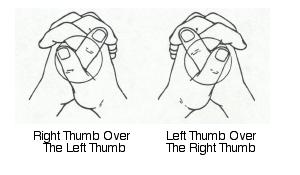
What is your phenotype ? _________________________________________
What is your genotype ? __________________________________________
Widows Peak
Some individuals have a hair line which dips to
a slight “V shape” in the middle of their forehead (see diagram below)
If you have a widow’s peak you inherited the dominant trait.
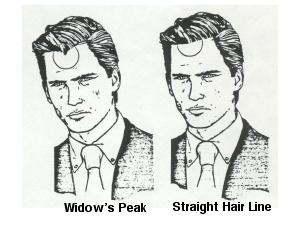
What is your phenotype ? _________________________________________
What is your genotype ? __________________________________________
Mid Digital Hair
The allele for hair on the middle segment of your
fingers is dominant to the allele for no mid digital hair (see diagram
below). Look in the area between your nail and the mid joint, see
if you have any hair in the mid digit area. If you have hair you
have the dominant gene.
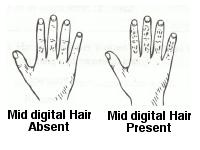
What is your phenotype ? _________________________________________
What is your genotype ? __________________________________________
PART ONE
DATA COLLECTION:
Use the Traits Chart
to collect the data that you generated by looking at your traits.
Then collect the data that your classmates observed. Use this table
to generate class percentages for each trait.
PART TWO
OBSERVATIONS:
The following are sex linked traits which are caused by a single gene. Sex determination is encoded in the X and Y genes. There are genetic diseases and certain characteristics that are associated with the sex chromosomes.
Barr Bodies
In 1948, before the discoveries of Lyon, Barr and Bertram found that in the interphase nucleus of female cat neurons there were a significant number of cells that had one "darkly staining body" lying along the edge of the nucleus, They never found a "darkly staining body" in the neurons of male cats. Similar "darkly staining bodies" are found in buccal epithelial cells of human females, although they can usually be found in only 30% to 40% of all human cells.
Normal males never express these "Barr bodies." In all cases, the number of Barr bodies is one less than the number of X chromosomes in an individual. One Barr body means the individual has two X chromosomes, two Barr bodies means the individual has three X chromosomes, etc. We now know that the "darkly staining" Barr body is the condensed, inactive X chromosome. The inactive X usually lies along the edge of the interphase nucleus in a highly condensed state. It is always the last to replicate. Take a look at the slide below for an example of a Barr body.
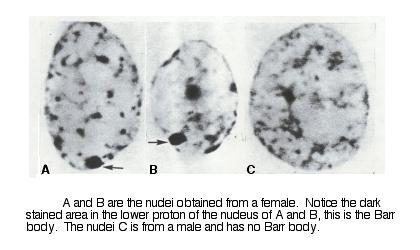
Color Blindness
Red green color blindness is transmitted through
the sex chromosomes. Below is a test to determine if you have the
symptoms of color blindness. Remember this is only a test, and you
can only be “officially” diagnosed by a medical doctor.
The test consists of 19 plates which are color coded. Individuals can observe different degrees of color. These variations can indicate if a person has difficulties in color perception.
Use the test chart
so you can record the numbers that you observe from the test plates.
In the back of the book of test plates there is a answer or score sheet
where you can check your answers.
Hemophilia
Hemophilia is a X linked inherited disease which
effects one in 10,000 males. In X linked inheritance a male always
receives a sex linked condition from his mother, from whom he inherited
the X chromosome. Let us assume a non effected male mates with a
female carrier. If the offspring is a male he has a 50% chance
of being effected with the trait. If the offspring is a female she
has a 50% chance of being a carrier.
The classic study of the European royal families is best used to describe the transmittance of the X linked disease. A pedigree is a chart which shows the pattern of inheritance for a particular condition by mapping the matings and their offspring. A pedigree is like a family tree that maps out a disease state.
Attached you will find a simplified pedigree that represents the European royal families. This chart will help you to visualize the passing of this X linked trait and to answer the questions below. Remember that this pedigree only represents the crossings that produced individuals that carry the X linked trait. There are no hemophiliacs in the present British royal family because Victoria’s eldest son, King Edward VII, did not receive the gene and therefore could not pass it on to any of his descendants.
How many sons did Queen Victoria and Prince Albert have that were effected?________
How many females did Alice and Louis IV produce that were
carriers?_________